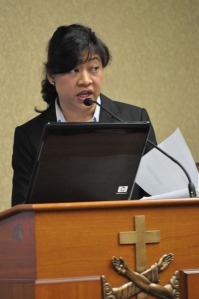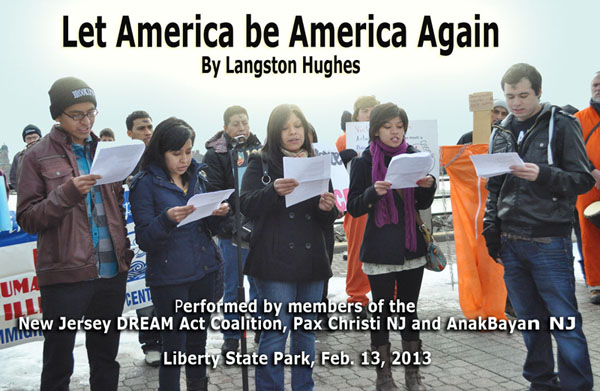What is wrong with the U.S. immigration system?
Leave a commentNovember 7, 2013 by Noel Pangilinan

Lawyer Cristina Godinez discusses what’s wrong with the U.S. immigration system.
Photo by NOEL T. PANGILINAN
By Atty. Cristina Godinez
(Condensed version of a presentation during the “Stand Up for Immigrants” forum sponsored by the Migrant Center at the Church of St. Francis of Assisi in midtown Manhattan on Nov. 2)
IMMIGRATION reform is usually associated with any measure that deals with the presence of 11 million undocumented persons in the United States. Often the debate is reduced to a choice between finding a way for them to earn legalization, or finding a way for them to leave.
If you asked an undocumented person whether she would have done what it took to earn legal status in the U.S. the answer would almost always be a resounding “Yes. Yes, if only there was a way.” But more often than not, there is no way.
Limited means of immigrating
In general, there are four ways to immigrate to the U.S., namely:
1.) Through family-petition;
2.) Through employer sponsorship;
3.) As a humanitarian benefit; or
4.) By being a national of a country that has low immigration rates to the U.S.
U.S. citizens can file a petition for their spouses, parents, children and siblings to immigrate to the U.S., while Legal Permanent Residents (also called ‘Green Card Holders’) can file a petition for their spouses and unmarried children. No other family relationships qualify.
People who wish to come to the U.S on an employment-based visa must have a job offer in the U.S., and the employer must be willing to sponsor them. This can be a long and expensive process.
The U.S. also provides protection to persons who are seeking refuge or asylum based on a well-founded fear of persecution because of their race, religion, membership in a social group, political opinion or national origin.
A person from a country with low immigration rates to the U.S. can also obtain a green card by random selection, under the Diversity Visa (DV) Lottery.
Humanitarian benefits and the DV lottery are open only to an extremely small group of qualified persons.
Most immigrants come to the U.S. through family petitions and employer sponsorships. In other words, a foreigner has no way of immigrating to the U.S. if he or she has no qualifying relationship with a U.S. citizen or green card holder, or has no job offer from a U.S. employer who is willing to go through the long and costly process of sponsoring a foreign worker,
Yearly immigrant visa quota is too low
The demand for immigrant visa exceeds the yearly quota. In general, U.S. immigration law provides an annual worldwide immigrant visa quota of 675,000. Meanwhile, millions of people immigrate to the United States each year.

Fr. Julian Jagudilla, director of the Migrant Center at the Church of St. Francis of Assisi, welcomes the crowd who attended the immigrant rights forum.
Photo by NOEL T. PANGILINAN
The gap between visa availability and visa demand is so wide that in 2011, for instance, 4.6 million people with approved family and employer petitions were waitlisted for visa applications. In 2012, 4.4 million were in the waitlist.
Although spouses, parents and children of US citizens can apply for visas regardless of the annual quota, other close relatives (including children over 21) have to wait for years to join their family in the US. The most egregious example of the resulting backlog is that of a naturalized U.S. citizen who would have to wait for more than 20 years to be reunited with his or her sibling from the Philippines.
Per country limits are unrealistic
Per country limits were set by Congress in 1976 so that regardless of immigration rates, every country has the same annual quota. As a result, high-immigration countries like Mexico or India have the same annual quota as low-immigration countries like Belgium or Iceland.
For 2013, only 26,600 immigrant visas per country are available. This severely constricts the flow of immigrants from 12 countries that represent 77 percent of the total number of persons in waitlists for green cards.
The top 12 countries with the highest number of waitlisted applicants are:
1. Mexico 1,316,118
2. Philippines 462,145
3. India 332,846
4. Vietnam 267,281
5. China 240,637
6. Dominican Rep. 169,422
7. Bangladesh 161,896
8. Pakistan 115,903
9. Haiti 106,312
10. Cuba 87,485
11. El Salvador 77,107
12. Jamaica 61,204
All Others 1,014,337
Worldwide Total 4,412,693
The per country limit does not take into account many factors that make countries different from one another, such as population size, historical ties with the U.S., or level of economic development.
Enforcement-based approach
Restrictive visa provisions are compounded by enforcement-heavy policies, which ironically end up contributing to the increase in the number of undocumented persons in the U.S.
- Three-year / 10-year bar from entering the U.S.
Persons who overstay and later leave the U.S. will not be allowed to come back either for three years or 10 years depending on how long they have overstayed. To avoid being barred from coming back, many of those who overstay opt to remain in the U.S. without status and become part of the undocumented population.
- Expanded border patrol since 1990
Expanded border enforcement along the U.S.-Mexico border beginning in the 1990s made crossing more dangerous and expensive. Many unauthorized immigrants opted to remain in the U.S. rather than return to Mexico. In the 1980s, unauthorized migrants typically stay for two to three years in the U.S. But by 1990, it was nine years. The so-called ‘circular’ flow of migration was reduced and in some cases stopped.
- Heightened interior enforcement
Heightened interior enforcement is taking place full-throttle. For instance, non-citizens are strictly monitored through such requirements as reporting a change of address within 10 days of moving. Employers are required to maintain records that their workers are authorized to work in the U.S., and these records are subject to random inspection by immigration authorities.
Workplace raids have been particularly aggressive during the past five years. Among the most notable was the Postville, IA raid that led to the arrest of 400 migrant workers at a kosher meatpacking plant in May 2008. About 300 of them were convicted in a matter of four days and a majority of them served their sentence for five months and then deported. Three months later, the raid at Howard Industries in Laurel, MS led to the arrest of 600 migrant workers.
Since 2009, the trend in workplace raids became less insidious with the so-called ‘silent raids’ or ‘audits’ which usually lead to the firing of foreign workers who do not have work authorization, though not necessarily to deportation.
On the average, ICE detains 400,000 migrants in about 33,400 facilities. In 2011, it detained a record number of about 430,000.
In the meantime, the impact of these deportation and detention drives extends to the families of undocumented migrants. About 5.5 million children in the US have at least one undocumented parent. Studies show their social development is compromised by the mixed immigration status of their families. Many children whose parents were either detained or deported end up in the child welfare system.
All said, America has spent $187 billion on immigrant enforcement since 1986 and it has not been working. The most recent estimates show that as of 2012, the decline in the undocumented population may have reversed. It is possible to expect more unauthorized immigration if things do not change and the system is not fixed.
As we take on the challenge of pursuing these changes in the immigration system, we might do well with this piece of advice from John F. Kennedy’s “A Nation of Immigrants”:
Immigration policy should be generous; it should be fair; it should be flexible. With such a policy we can turn to the world, and to our own past, with clean hands and a clear conscience.”
(Cristina Godinez is a New York attorney involved in immigration law and in advocating for immigrant rights.)




